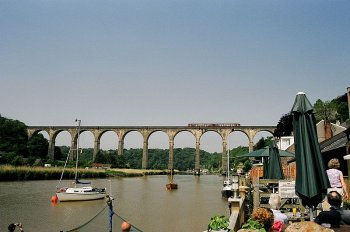


Riverside village dominated by a viaduct
Web: www.visitcornwall.com/destinations/calstock
An important river port since Saxon times, Calstock clings to the steep Cornish bank of the River Tamar 14 miles upriver from Plymouth Sound and about two miles south of the A390 road. The river is navigable to boats past Calstock some three miles upstream to Morwellham Quay with some ten feet of water. The population of the village was 6,431 at the 2011 census.
Calstock is a pretty village full of whitewashed cottages that tumble down to the water's edge. The skyline is dominated by an imposing viaduct of some 120 feet high that spans the river; an endless stream of boats of all shapes and sizes sail through the arches throughout the day.
In the Victorian era when steamers brought tourists to the village, Calstock was visited by Queen Victoria and Prince Albert in 1846.
Calstock had two main boat builders, Goss's Yard, which built the Tamar sailing barge, 'Garlandstone', now moored at Morwellham Quay, and May's Yard, in the Danescombe Valley.
There are four sets of lime kilns at Calstock and another at Cotehele Quay. The burning of lime was a major industry in the area in the 19th century. The limestone was delivered to the kilns by boat but the resulting lime shipped out to the various farms by horse and cart. It was used as a fertiliser, an ingredient in paint and as a mortar for bricklaying.
St. Andrew's is the Parish church and is one of the oldest buildings in the village, dating from the 13th century. A Roman Fort, only the third known in Cornwall, was discovered next to the church in 2008.
One of Britain's loveliest railway branch lines runs along the Tamar Valley from Plymouth to Gunnislake, offering breathtaking views and many opportunities to alight and explore the footpaths through woods and gorges. Calstock railway station opened on 2nd March 1908. At Calstock the railway crosses a spectacular 120 foot high viaduct, built in 1907.
The East Cornwall Mineral Railway was a 3 foot 6 inch gauge railway line, opened in 1872 to connect the mines and quarries in the Callington and Gunnislake areas in east Cornwall with shipping at Calstock on the River Tamar. The line included a rope-worked incline to descend to the quay at Calstock. Wagons with goods from the mines were brought down the hillside on a 0.4 miles cable-worked incline with a gradient of 1 in 6 (17%).
Following the opening of the LSWR mainline railway at nearby Bere Alston, a connecting line from there to Calstock was opened, and the existing line converted to standard gauge, opening throughout as a passenger line in 1908. When rural lines in the area were closed in the 1960's under the Beeching Axe, a short section of the original ECMR line was retained to keep open a connection from Plymouth to Gunnislake, and that section remains open.
West of this former inland port lies the National Trust property of Cotehele House, for centuries the Edgcumbe family home, and one of the best preserved late-medieval houses in the South West.
It was also a thriving mining community in the past with a much larger population than today. Now it is much quieter and there are shops, restaurants and cafes.
Calstock Community Primary School was built in 1901 and opened on 6th January 1902. At that time the school consisted of just two main classrooms. It has since been extended with the addition of the infant suite. The infant suite extension won an award for architectural design, in keeping with the remainder of the school.
There is a ferry service from the quay to Cotehele during the summertime only.
Calstock still has station on The Tamar Valley Railway Line serving the village.
The Sky One drama, 'Delicious', starring Dawn French, Iain Glen, Emilia Fox, and Sheila Hancock, filmed scenes in Calstock, drawing attention to the village as a location.
Calstock was the resting place of many members of the Grenfell family.
Dawn French moved here in 2021.
Calstock Festival - June.
Calstock Advent Windows - 1st December.
Callington Cotehele House Cotehele Mill Cotehele Quay Gunnislake Launceston Saltash
Cotehele Gallery The Tamar Valley Donkey Park The Tamar Valley Tamara Way